
22 minute read
ChaPTer 18 Dental Laboratory Materials
Chapter
18 Dental Laboratory Materials
Advertisement
Objectives Upon completion of this chapter, the reader should be able to identify and understand terms related to the following: 1. Impression materials. Identify the various kinds of rigid and elastic impression materials, and give examples of each. 2. Gypsum materials. Discuss the assorted types of gypsum products used in dentistry, and give examples of their uses. 3. Wax materials. Identify the different kinds of dental waxes, and discuss a use for each type of wax. 4. Dental polymer materials. Explain the process of polymerization and the factors that alter or modify the chemical reaction, as well as the uses for the polymer materials. 5. Precious and base metals. Describe the difference between precious and other metals, and state uses for the assorted types of gold. 6. Abrasive and polishing materials. Identify the common abrasives and polishing materials used in dentistry and the desired effect of each. 7. Cement materials. List the various types of dental cements, and state the uses for each type. 8. Characteristics of dental laboratory materials. Discuss the different types of descriptive or manipulative characteristics of dental materials.
Impression Materials
Dental laboratory procedures involve a variety of procedural steps or techniques and the use of many materials. These materials may be grouped into families according to composition or use. Each material exhibits its own particular characteristic, and one substance may differ from another even
within its own grouping or family. Knowledge of the general and specific use of a dental material is essential to successfully complete many laboratory procedures.
The assortment of materials needed to complete the various dental lab procedures is not limited to the lab area. They may be used alone, or they may be used in conjunction with the dental operatory/treatment room.
Types of Impression Materials
Impression materials are substances that are used to take and record the shape, size, or position of teeth, appliances, and oral anatomy. These materials may be rigid, plastic, or elastic.
Rigid Impression Materials
Rigid impression materials are used where no teeth are present, and material flexibility is unnecessary. The assorted types of rigid impression materials are: impression plaster: gypsum product, 60 cc of water to 100 grams of plaster. metallic oxide paste: two-paste system, zinc-oxide eugenol (ZOE) base with resin accelerator. This paste hardens through chemical reaction. impression compound: supplied in cakes and sticks; color-coded for temperature flexibility; used to make a preliminary impression tray.
Plastic Impression Materials
Plastic impression materials are used with or without the presence of teeth. This movable material is employed where some material flexibility is needed for the impression. The three types of plastic impression material are: = thermoplastic: material softens when heated and hardens when cooled. = compound: supplied in sheets or stick form. The material is composed of a thermoplastic resin base with filers and plasticizers. It softens when heated and returns to a solid when cool; used in copper bands for independent crown preps. = wax: used for registration of bites or for impression of a single tooth area.
Elastic Impression Materials
Elastic impression materials are used where teeth are present and material must be flexible for removal from the oral cavity or teeth. Elastic impression materials are either reversible or irreversible hydrocolloids: reversible hydrocolloid: impression material that can change repeatedly from gel to solid states depending on the thermal condition of the substance:
gel state: material is soft and pliable. solid state: material has “set” or is rigid enough to hold the form. irreversible hydrocolloid: agar impression material that can be changed from gel to solid state as a result of a chemical reaction, and remain in that condition after mixing and using. For example, alginate powder or premixed packages are supplied in regular or fast set, tinted, and flavored (see Figure 18-1A for an example of an alginate impression).
Elastomeric Impression Materials
Elastomeric impression materials are used to make impressions of preparations and for demanding or accurate reproductions. These substances are composed of a base and an accelerator, or catalyst (CAT-ah-list = substance that speeds up the chemical reaction) and can be measured, mixed, and placed in a tray or syringe for use in the mouth. The material may be hand mixed or placed in an extruder gun, which is a device that contains two independent materials to be forced mixed and dispensed into a common tip as one material, thus eliminating measuring, mixing, and cleanup time. polysulfide: impression substance available in light, regular, or heavy-bodied viscosity (viss-kAhs-ah-tee = thickness or tendency to flow). Also known as mercaptan, this material will harden or set by means of chemical action. silicone: first supplied as a base putty with liquid accelerator drops and termed condensation or conventional silicone type or later as a two-paste system known as addition silicone type. polyether: supplied in regular viscosity, with a thinner modifier (MAh-dihfye-er = material to change conditions) for reduced thickness. vinyl polysiloxane: impression material supplied in tubes, putty, paste-topaste system, and cartridge styles. The material may be heavy, medium, or wash viscosity; impressions may be poured more than once. The material is stable. Some have bubble gum flavoring. See Figure 18-1B for an example of an elastometric impression using a heavyweight and lightweight viscosity material.
Digital Impression Technique
Another method to take an impression of a prepared site to present to the dental laboratory scene is digital capture and file transfer. Without the use of trays, tubing, or impression material, an impression of a prepared procedure, either one or multiple preps, may be obtained by an optical scan of the area. Using a wand device, one or both dentitions may be scanned, reviewed by the dentist, and forwarded to the dental laboratory for polyureothane model construction. The prosthodontist or lab technician then constructs the prescribed prosthesis for that case. See Figure 18-1C for an example of the finished impression made from the digital reading of the preparation.
© Cengage Learning 2013
(A)

Courtesy of Roe Dental Labs
(B)
Figure 18-1
(A) alginate impression (B) elastometric impression (C) laboratory reproduction result from a digital impression
(C)
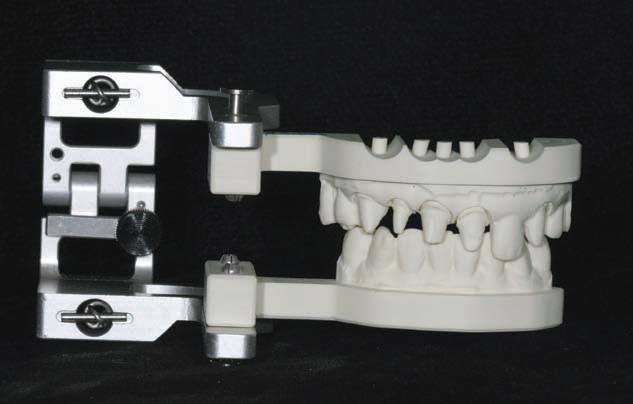
Gypsum Materials
Types of Gypsum
Gypsum products generally are obtained from the same rock or ore source: calcium sulfate. It is the calcination process of preparing and handling the gypsum material that determines the final classification and purpose of a gypsum product. Gypsum products can be color-coded for types and speeds.
The five types of gypsum are: = Type I plaster – impression: used to take impression but not popular because of its weakness and replacement by better impression materials. = Type II – model: also known as plaster of paris, used mostly for impression and study models. Prepared by dehydrating calcium sulfate at atmospheric pressure to beta-hemihydrate form. = Type III – dental stone: white or buff colored, Class I stone, used for orthodontic, diagnostic, and working casts. Prepared by dehydrating gypsum under pressure for alpha-hemihydrate form. = Type IV – improved or die stone: stronger Class II stone used for dental dies and casts. It is dehydrated in a solution of calcium chloride to obtain a modified alpha-hemihydrate form; also known as densite. = Type V – casting investment: gypsum-bonded material that can withstand extreme heat; used for casts of a prosthesis.
Other casting substances include phosphate and silica-bonded investment materials.
Use of Gypsum Materials
Gypsum products have a variety of uses in the dental office and the laboratory setting in the construction and fabrication of dental prostheses. Related terms are: model and cast: used for a positive reproduction of the mouth and oral conditions. The gypsum model, called a diagnostic cast or study model, consists of an art portion (base) and an anatomical (tooth) portion. Study models can be used as patterns for construction, legal records, and examples of before-and-after treatment, as well as planning and preparation (Figure 18-2A). Study models may also be constructed by 3D digital methods.
A wand scan is taken of the mouth, and the readings are sent to a laboratory for construction of a study model. Figure 18-2B shows an example of a digital study model set. die: reproduction of prepared tooth; usually Class II stone poured into an impression of the preparation. Dies can be electroplated (ee-LECktroh-play-ted = thin metal covering through electrolysis) with copper, silver, amalgam, or low fusing metals for a stronger surface and working area.

(A)
© Cengage Learning 2013


Courtesy of Roe Dental Labs
(B)
Figure 18-2
(A) Plaster study model; (B) digital study model
Wax Materials
Wax is supplied in sheet, stick, round and square shaped wire rope, and block forms for use in various dental procedures. Figure 18-3 gives examples of dental waxes. They include both synthetic and natural products from animal, mineral, and vegetable sources. The combination of material and the manufacturing
(A)
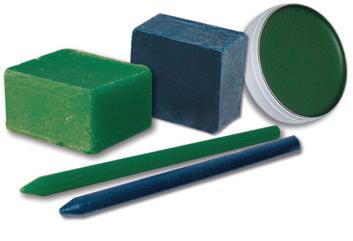

(C) (B)

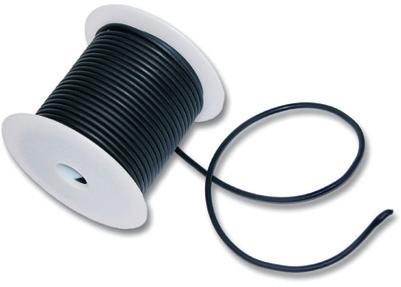
(D)
Figure 18-3
Examples of various waxes: (A) inlay wax, (B) occlusal bite rims, (C) boxing wax, (D) wax rope
Courtesy of Carmel Industries
process determines the ability of the wax to complete its designed purposes. Types of wax materials are: inlay wax: hard wax; blue, purple, green, or ivory colors; available in 3–4 inch sticks. Type I is for direct oral use; Type II is for laboratory or indirect use for inlay, crown, and casting patterns. baseplate wax: supplied in 3 × 6-inch sheets, pink in color and soft, medium, or hard; used for denture construction, bite registration, and prosthesis construction. casting wax: available in square sheets of various thicknesses; colors denote its softening point; used for construction of patterns for cast partial dentures. boxing wax: supplied in 1-1/2 × 12 × 1/8-inch strips; used to box or wrap around an impression prior to pouring. The strips hold the plaster or stone in place to form the art base of a study model.
occlusal bite blocks: wax blocks in arch shape; used to set in teeth to be used for denture constructions. They are laboratory made by folding boxing wax and shaping, or they can be purchased premade, which saves time and is more consistent. bite wafer wax: used to check occlusion relationships; supplied in a preformed bite shape with a foil center to prevent bite through. orthodontic wax: soft, white stick wax used in orthodontics; used to line borders of impression trays. wax round wire: supplied on reels in various gauges; used to make lingual bars, sprues, and metal framework space. utility wax: soft, adhesive wax, supplied in stick or sheet; used to mount casts and to adapt or modify impression tray edges; also called rope wax. sticky wax: hard, brittle wax stick that is melted to hold dental units together. preformed wax pontic shapes: eliminates wax buildup process; supplied in various shapes and sizes of teeth. disclosing wax: also known as pressure indicator paste; painted on an appliance, inserted into the mouth, and pressure applied to indicate high, sore, or tender areas; may be used to repair wax pattern voids. miscellaneous waxes: assorted color-coded waxes with particular fine-turning properties, such as margins, sculpturing, blocking out, and dipping. Figure 18-3 shows an assortment of dental waxes.
Dental Polymer Materials
Dental polymers, known as a synthetic resins or acrylics, are the result of a chemical union of monomer and polymer substances. The chemical union of these chains is called polymerization, also known as curing. There are two types of acrylic: autopolymer (self-cured) and thermopolymer (heat-cured). Among the substances included in the polymerization process are the following: filler: inert substance added to the polymer to alter or modify the polymer properties. initiator (in-NIsh-ee-ay-tor = agent capable of starting polymerization process): may be light, heat, radiation, or chemicals. activator: reacts with initiator to start polymerization. inhibitor (in-hIB-bih-tore = substance that prevents polymerization): maintains storage life. plasticizer (PLAs-tih-sigh-zer = substance that causes a softening effect): changes hard, brittle resin into a flexible, tough material. composite: polymer matrix bonded to glass particles; used for dental restorations. self-curing resins: autopolymerization materials that perform the uniting process by means of a chemical union; the activator is present in the polymer powder or base and does not have to be added. heat-cured resins: acrylic materials are united but need outside heat to set up; not as popular as self-cured but less likely to present bubbles or voids when processed correctly.
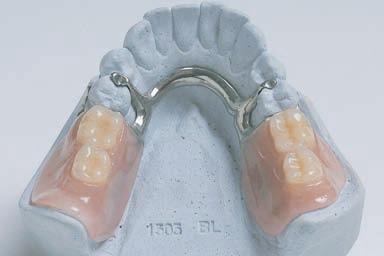
(A)
© Cengage Learning 2013
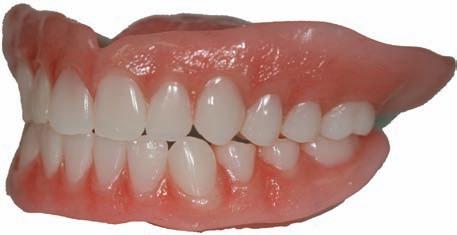
(B)
Courtesy of Roe Dental Labs
Figure 18-4
Examples of resin used with (A) partial framework or (B) complete denture
Some of the more common polymers used in dentistry are for denture bases, denture liners and repairs, denture teeth, custom impression trays, orthodontic and dental appliances, mouth guards, tooth-bleaching trays, metal casting veneers, pit and fissure sealants, and tooth restorations.
Artificial teeth used in dentures and appliances may be acrylic (resin) or porcelain (ceramic) (see Figure 18-4).
Precious and Base Metals
Many different metals are used in dental procedures. Some are used in their pure state, and others are used in combination with other metals. A combination of two or more metals is called an alloy (AL-loy). Combinations of two metals are binary (BYE-nar-ee); three metals are ternary (TURN-ah-ree); four metals are quaternary (kwAh-ter-nare-ee); and five different metals make up a quinary (kwIN-ar-ee) alloy.
Metals are classified as precious metals or base metals. Precious or “noble” metals—gold, platinum, palladium, and silver—are used for crowns, bridges, and dental appliances.
Gold Alloy
Pure gold (24 carat) may be used for gold foil restorations, and gold alloys formed with other precious metals, copper, or zinc may be supplied in sheet, wrought, or solder forms. Gold alloys can be tempered (hardened) or annealed (softened). They can also be whitened by adding silver, platinum, or palladium. Gold alloy solder is used to join parts of dental appliances or for repairs. Gold castings are classified into the four types shown in Table 18-1.
Table 18-1 Types of Gold Casting Alloy
Types Consistency Use
Type I (A) Soft Used for simple, nonstress surface, inlays Type II (B) Medium Preferred in stress-bearing inlays or onlays Type III (C) Hard Used in crowns and short-span bridgework Type IV (D) Extra-hard Preferred for partial denture frames, saddles, and clasps
Base Alloy
Type III is the most commonly used noble alloy. The basic combination for this alloy is: = 75% gold: resists tarnish/corrosion, nontoxic, hypoallergenic, docile, malleable, low melting point, and burnishes (smooths out) well. = 10% silver: lessens the red cast from copper and gold, increases ducility and malleability; gives strength to the alloy. = 10% copper: hardens in heat and high temperature; adds flowability. = 3% palladium: increases hardness, whitens gold, and prevents tarnish and corrosion. = 2% zinc: prevents porosity of surface areas, and provides smoothness.
Base metal alloys contain less than 25% of noble metals and usually consist of chromium, nickel, and cobalt. They are used in partial denture frameworks or as substitutes for gold alloy. Other metals include stainless steel for crowns, orthodontic materials, nickel chromium, and cobalt-chromium for orthodontic wires.
Abrasive and Polishing Materials
Finishing a dental prosthesis is a matter of smoothing and polishing. An abrasive material reduces or removes bumps, overhangs, and excesses but leaves behind scratches and surface cuts. A polishing agent reduces these scratches to an unnoticeable flat surface that reflects light. The technician begins the procedure with an abrasive material and then changes to a polishing agent to produce a shining surface. Abrasive and polishing materials may be supplied as powder to form a paste or slurry (sLUR-ee = thin, watery mixture), or luted to paper or cloth into sheets. Abrasives can be impregnated into wheels and points, or supplied in solid bricks that may be rubbed on rag or brush wheels for use with the dental lathe machine. Some common abrasive and polishing materials supplied in various grits on strips, discs, wheels, bricks, and powders are listed in Table 18-2.
Table 18-2 Common Abrasive and Polishing Agents
Material Supplied As Agent Use
aluminum oxide mounted stone, slurry abrasive/polish acrylic resin carborundum stones, points, disc abrasive metal, resin, tooth chalk soft powder polishing gold, resins
chromium oxide powder polishing stainless steel
cuttle powder of fish shell abrasive gold alloys
diamond various size particles abrasive tooth structure
emery
garnet pumice
quartz
rouge tin oxide
tripoli particle or luted to cloth abrasive stone, points abrasive trim acrylic resin, composite
powder, slurry abrasive
grits, luted to paper, discs abrasive metal, enamel, resin
general use
powder, brick polishing gold, denture resin
powder, slurry polishing metals
stone, brick polishing gold alloy
zirconium silicate powder polishing enamel
Cement Materials
Dental cements are used to temporarily or permanently lute dental castings, crowns, and bridges in place. These same cements, in thicker viscosities, can be used as bases or as restoratives in operative dentistry. The most common luting cements used with the dental laboratory products are zinc phosphate, ZOE, polycarboxylate (pahl-ee-kar-BOX-ih-late) and resin. The common cements used in dentistry are listed in Table 18-3.
Table 18-3 Dental Cements or Luting Agents
Material
zinc phosphate
ZOE
Use
Permanent luting of casting, orthodontic appliances. Type II is used as a base. Temporary luting for castings, pulp capping, cavity liner, periodontal dressing, temporary restoration, insulating base, and wash.
Material Use
ZOE and EBA (orthoethoxybenzoic acid) Type II permanent cement for inlays, onlays, crowns, and bridges.
polycarboxylate Luting for castings, stainless steel crowns, orthodontic cement.
silicophosphate Luting for orthodontic appliances. resin (light and self-cure), ESPE Luting for castings, porcelain restorations, Maryland bridge. glass ionomer Type I cementation of metal castings, direct bond ortho bands, and core buildup. Type II is for anterior restorative.
Characteristics of Dental Laboratory Materials
When working with the various dental laboratory materials, you must be aware of and understand the descriptive or manipulative characteristics of strengths of each material. Related terms are: bonding: force of the union of one substance with another substance. coefficient of thermal expansion: amount of form change that takes place in a dental material and tooth during heat exposure in the oral cavity. color: has three components:
= hue: color of object—red, green blue, and so on. = chroma: strength of specified hue. = value: darkness or brightness of specified hue. creep: tendency of amalgam to deform under constant applied pressure. cure process: hardening of the material through auto- (chemical) or lightactivated response. ductility: ability of the material to withstand permanent deformation without fracturing under elongation stress. elasticity: ability of a material to return to its original form when stress is removed. exothermic (ecks-oh-ThER-mick): chemical release of heat, as in zinc phosphate cement. flow: slow bending or movement of material under its own weight. galvanization: tendency of certain metals to produce an electrical charge when in contact with each other. hardness: maximum amount of resistance before penetration or scratching can occur. hydrophilic (high-droh-FIL-ick = ability to attract and hold water): absorption of water. hydrophobia (high-droh-FOh-bee-ah = fear of water): giving off or shedding of water.
Review Exercises
hygroscopic (high-groh-skAh-pick) expansion: submersion into, or the addition of, water to a material prior to initial set. initial set: period of time when material assumes shape but remains pliable. imbibition (im-bah-BIsh-shun = absorption of fluid): taking on of water. malleability: ability to withstand deformation without fracture while undergoing maximum compression stress. setting time: amount of time required for the material to become as hard as it will be. tensile strength: maximum amount of pulling stress required to rupture the material. thermal conductivity: capability of the material to transmit heat. toughness: ability of the material to resist fracture. trituration: mixing of mercury with other alloy material to form an amalgam. working time: period during which a material can be molded, shaped, or manipulated without any adverse effect upon the material. yield strength: maximum amount of stress a material can withstand without deformation.
Matching
Match the following word elements with their meaning. 1. ____ catalyst A. inert substance added to alter properties 2. ____ plasticizer B. gypsum reproduction of a prepared tooth 3. ____ study model C. substance that changes material’s action 4. ____ filler D. strip to encircle impression tray prior to pour-up 5. ____ imbibition E. synthetic resin 6. ____ boxing wax F. hard, brittle wax used to hold objects together 7. ____ Type IV gypsum G. taking on of water 8. ____ alloy H. substance to prevent polymerization; helps storage 9. ____ sticky wax I. runny, watery mix 10. ____ slurry J. elastic impression material 11. ____ reversible hydrocolloid K. positive reproduction of the mouth 12. ____ acrylic L. combination of two or more metals 13. ____ inhibitor M. improved stone 14. ____ modifier N. substance that causes softening effect 15. ____ die O. substance to speed up chemical reaction
Definitions
Using the selection given in each sentence, choose the best term to complete the definition. 1. Which of the following is not considered a precious or noble metal? a. amalgam b. gold c. platinum d. silver 2. A dark blue wax used to make wax patterns for cast restorations is: a. baseplate wax b. boxing wax c. inlay wax d. sticky wax
3. A hard, brittle stick wax that is melted to hold together dental items is: a. baseplate wax b. boxing wax c. inlay wax d. sticky wax 4. A pink sheet wax that is used for denture construction of the gingival area is: a. baseplate wax b. boxing wax c. inlay wax d. sticky wax 5. An inert substance added to the polymer to alter or modify the polymer’s properties is: a. composite b. filler c. plasticizer d. inhibitor 6. Which type of gold alloy is preferred for use in crown and bridge work? a. Type I b. Type II c. Type III d. Type IV 7. Which of the following is not considered an impression material? a. gypsum b. amalgam c. compound d. metallic oxide 8. Gypsum products may be used for all of the following except: a. restorations b. impressions c. study models d. investment 9. Which wax is supplied in strips and placed around the impression tray prior to pouring? a. boxing b. casting c. inlay d. sticky 10. Which class of stone is classified as improved stone and used to make dies? a. Class I b. Class II c. Class III d. Class IV 11. The period of time when material assumes shape but remains pliable is called: a. working time b. initial set c. setting time d. form time 12. A material that softens when heated and hardens when cooled is said to be: a. exothermic b. intrusive c. rigid d. thermoplastic 13. A substance composed of two or more different substances is called a/an: a. union b. compound c. hygroscopic d. elastic 14. Which of the following metals is used in a Type
III alloy to provide porosity to the alloy? a. zinc b. copper c. gold d. silver 15. In a comparison of two materials, the one with a heavier viscosity would be: a. thicker b. less stable c. same thickness d. thinner 16. A substance used to take and record the shape, size, or position of items is a/an: a. implant b. investment c. inlay d. impression 17. How many carats are in the precious metal pure gold? a. 10 b. 12 c. 20 d. 24 18. Polysiloxane impression material is not supplied in which of these viscosities: a. slurry b. heavy c. wash d. medium 19. Which of the following finishing agents is considered an abrasive agent? a. chromium oxide b. chalk c. carborundum d. tin oxide 20. Trituration is another term for which process? a. heating b. polymerization c. amalgamation d. curing
Building Skills
Locate and define the prefix, root/combining form, and suffix (if present) in the following words. 1. thermoplastic prefix ___________________ root/combining form ___________________ suffix ___________________ 2. polycarboxylate prefix ___________________ root/combining form ___________________ suffix ___________________
3. exothermal prefix ___________________ root/combining form ___________________ suffix ___________________ 4. polymerization prefix ___________________ root/combining form ___________________ suffix ___________________ 5. electroplated prefix ___________________ root/combining form ___________________ suffix ___________________
Fill-Ins
Write the correct word in the blank space to complete each statement. 1. The mixing of mercury with other metal alloys is a/an ____________________________. 2. A thin, watery mixture of an abrasive material is a/an ___________________________. 3. A mixture of five different metals is a/an _______________________ alloy. 4. A/an _____________________________ is added to resin material to cause a softening effect. 5. A/an _____________ is a reproduction of a prepared tooth for a crown or bridgework. 6. The time period when it is possible to mold, shape, or manipulate a material without an adverse effect upon the material is called _____________________________ time. 7. A/an ___________________ is a substance that speeds up chemical reactions. 8. Model plaster is also known as __________________ of _______________. 9. A/an ______________________________ process is used to coat a stone die with a thin metal sheeting cover. 10. An extruder gun is used to express __________________________ material to a preparation. 11. Slow bending or movement of a material under its own weight is termed ______________. 12. Toughness is the ability of a material to resist ________________________________. 13. Hue, chroma, and value are the three components of __________________________. 14. The forced union of one substance with another substance is ____________________. 15. Tin oxide, chalk, rouge, and tripoli are examples of a/an ____________________ agent. 16. __________________________________ is used to unite two metals in a prosthesis. 17. _________________________ is a fear of water or shedding off of water. 18. The polishing agent—rouge—would be used to obtain a shine on denture resin or _______. 19. _________________________ wax may be used for construction of patterns for partial dentures. 20. The maximum amount of stress at which metal will return to the original form when stress is removed is termed _______________________.
Word Use
Read the following sentences, and define the words written in boldface letters. 1. The dental technician warned the trainee to be careful of the exothermic chemical reaction that occurs when mixing the cement material. ________________________________________ 2. When following the fabrication prescription order for the prosthesis, the technician works with the alloy the dentist prefers. ________________________________________ 3. The dental assistant noted that the setting time of the new cement was different from the former brand of cement used in the office.
________________________________________ 4. The dentist asked the assistant to pour up the die impression with Class II improved stone. ________________________________________ 5. The technician noted that using some plaster slurry in the mix hastens the setting time. ________________________________________
Audio List
This list contains selected new, important, or difficult terms from this chapter. You may use the list to review these terms and to practice pronouncing them correctly. When you work with the audio for this chapter, listen to the word, repeat it, and then place a checkmark in the box. Proceed to the next boxed word, and repeat the process.
alloy (AL-loy) binary (BYE-nar-ee) calcination (cal-suh-NAY-shun) catalyst (CAT-ah-list) electroplated (ee-LECk-troh-play-ted) exothermic (ecks-oh-ThER-mick) hydrophilic (high-droh-FIL-ick) hydrophobia (high-droh-FOh-bee-ah) hygroscopic (high-groh-skAh-pick) imbibition (im-bah-BIsh-shun) inhibitor (in-hIB-ih-tore) initiater (ih-NIsh-ee-ay-tore) modifier (MAh-dih-fye-er) plasticizer (PLAs-tih-sigh-zer) polycarboxylate (pahl-ee-kar-BOX-ih-late) polymerization (pahl-ee-mare-ih-ZAY-shun) quaternary (kwAh-ter-nare-ee) quinary (kwIN-ar-ee) slurry (sLUR-ee) ternary (TURN-ah-ree)










